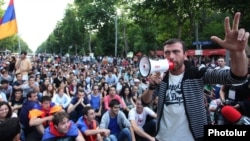Utility regulators cut the prices of electricity in Armenia by at least 2.6 percent on Friday, citing a recent decrease in domestic gas tariffs agreed with Russia’s Gazprom monopoly.
The Public Services Regulatory Commission (PSRC) lowered the daytime electricity price for the vast majority of Armenian households from 46.2 drams (about 10 U.S. cents) to just under 45 drams per kilowatt/hour.
The price for low-income families will fall by 13.4 percent to 40 drams per kilowatt/hour. They will pay 30 drams during night hours.
A senior PSRC official, Garegin Baghramian, attributed the lower tariffs, effective from February 1, to the decreased cost of natural gas used for generating at least one-third of Armenia’s electricity.
The PSRC approved late last month sizable reductions in the domestic prices of natural gas which were proposed by Armenia’s Gazprom-owned gas distribution network. Prime Minister Karen Karapetian, who managed the network from 2001-2010, called for the price cuts shortly after he took over the government in September.
Some Armenian observers and opposition politicians have linked these measures with the April 2017 parliamentary elections which the ruling Republican Party of Armenia (HHK) expects to win.
The utility regulators already cut the basic electricity price by 2.6 drams per kilowatt/hour in June this year. Nevertheless, energy became more expensive for most Armenians as the government essentially stopped subsidizing it in August. The government introduced the subsidy following the dramatic June 2015 demonstrations in Yerevan which were triggered by the PSRC’s decision to raise the cost of energy from 42 drams to almost 49 drams per kilowatt/hour.
The latest PSRC decision thus means that electricity in Armenia will still cost more than it did before June 2015.
Baghramian argued that the regulatory body could not have approved steeper price cuts because the Metsamor nuclear power station, which accounts for more than a third of Armenian electricity output, was brought to a halt this year for a longer-than-usual period of time. The Soviet-era plant is currently undergoing capital repairs and modernization aimed at extending its life until 2027.
“This is a very important factor,” Baghramian told reporters. “We are getting smaller amounts of cheap electricity, which has to be compensated by more expensive electricity generated by thermal-power plants.”
The official also cautioned that the energy tariffs will likely rise in the coming years because the Armenian government will need more cash to repay foreign loans financing the ongoing construction of new power transmission lines connecting Armenia to Iran and Georgia.






Facebook Forum